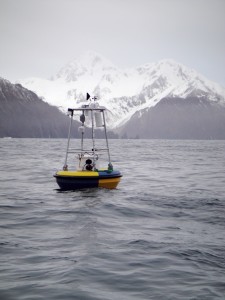UAF ocean acidification research expanding
June 8, 2012

907-474-7208
6/8/12
The state of Alaska and the University of Alaska Fairbanks will be throwing a wider net to collect data on ocean acidification in the coming years. The state allocated $2.7 million in the UAF capital budget during the 2012 legislative session for expanded ocean acidification monitoring.
“This is a tremendous opportunity to improve our understanding of a problem that could have far-reaching implications for our state,” said assistant professor Jeremy Mathis, the director of the Ocean Acidification Research Center at UAF. “This infusion of funding will allow us to do things that we didn’t think were possible a couple of years ago.”
Mathis will use the new funding to build a network of ocean acidification buoys around the state that will provide real-time monitoring of changing conditions throughout some of the state’s most sensitive coastal areas.
“We want to make sure that we are putting resources in areas where stakeholders are at risk due to the consequences of ocean acidification,” said Mathis, “When everything is in place, we’ll be making ocean acidification measurements from Sitka to the Mackenzie River.”
The new project will begin next month and Mathis plans to maintain the buoy network for at least four years. The funding will be used to maintain existing buoys in the Gulf of Alaska outside of Resurrection Bay and in the Bering Sea west of Bristol Bay, as well as deploy new buoys in 2013 near Kodiak and in Southeast Alaska between Juneau and Sitka. The Alaska buoy network will be part of a larger operation along the west coast of North America and will involve partner institutions such as the NOAA Pacific Marine Environmental Lab in Seattle.
Scientists will combine collected information with data from other research to develop a model to determine the current and future costs of ocean acidification. Mathis will work with scientists at NOAA fisheries labs in Kodiak and Newport, Ore., where researchers are studying the effects of ocean acidification on specific Alaska organisms like crabs and pollock.
“When we combine their laboratory data with our measurements from the field we can really start to look at this problem from an ecosystem perspective and that gives us some predictive capabilities,” said Mathis.
The data will be made available to the community in a number of different locations through a partnership with NOAA and the Alaska Ocean Observing System. Mathis will also continue talking with stakeholders around the state about the potential implications of ocean acidification and how data from the buoys can help communities as well as state and federal agencies plan for any future changes.
Organizations including the UAF Marine Advisory Program and the Alaska Marine Conservation Council worked with representatives in both houses of the Legislature and organized support for the funding request.
ADDITIONAL CONTACTS: Jeremy Mathis, UAF SFOS faculty, 907-474-5926, jtmathis@alaska.edu.
SW/6-8-12/270-12


